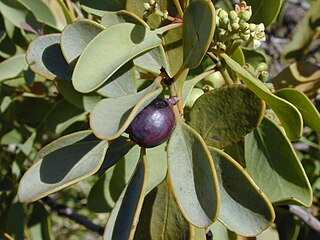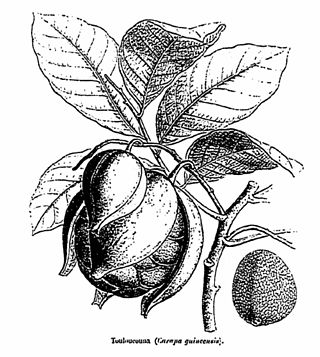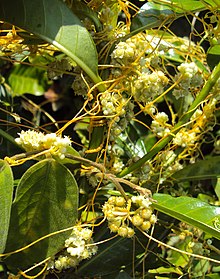
Cuscuta, commonly known as dodder or amarbel, is a genus of over 201 species of yellow, orange, or red parasitic plants. Formerly treated as the only genus in the family Cuscutaceae, it now is accepted as belonging in the morning glory family, Convolvulaceae, on the basis of the work of the Angiosperm Phylogeny Group. The genus is found throughout the temperate and tropical regions of the world, with the greatest species diversity in subtropical and tropical regions; the genus becomes rare in cool temperate climates, with only four species native to northern Europe.

Convolvulaceae, commonly called the bindweeds or morning glories, is a family of about 60 genera and more than 1,650 species. These species are primarily herbaceous vines, but also include trees, shrubs and herbs. The tubers of several species are edible, the best known of which is the sweet potato.

Viscaceae is a taxonomic family name of flowering plants. In this circumscription, the family includes the several genera of mistletoes. This family name is currently being studied and under review as in past decades, several systems of plant taxonomy recognized this family, notably the 1981 Cronquist system.

The Santalaceae, sandalwoods, are a widely distributed family of flowering plants which, like other members of Santalales, are partially parasitic on other plants. Its flowers are bisexual or, by abortion, unisexual. Modern treatments of the Santalaceae include the family Viscaceae (mistletoes), previously considered distinct.

Centranthera is a genus of plants in the family Orobanchaceae. The genus is distributed in Asia. There are about 10 species in this genus, and the majority have funnel-shaped flowers. In Nepal, Centranthera cochinchinensis is reportedly used an alternate fodder.

Pedicularis is a genus of perennial green root parasite plants currently placed in the family Orobanchaceae.
Shingba Rhododendron Sanctuary is a nature park in the Indian state of Sikkim. It has forty species of rhododendron trees. It is located in the Yumthang Valley of Flowers north of Lachung in North Sikkim district. Bird species found in the park include Wood snipe and Hoary-throated barwing. The sanctuary is part of the Sacred Himalayan Landscape.

Swertia is a genus in the gentian family containing plants sometimes referred to as the felworts. Some species bear very showy purple and blue flowers. Many members of this genus have medicinal and cultural purposes.

Cuscuta europaea, the greater dodder or European dodder, is a parasitic plant native to Europe, which belongs to the family Convolvulaceae, but was formerly classified in the family Cuscutaceae. It grows on Asteraceae, Cannabaceae, Chenopodiaceae, Fabaceae, Urticaceae and other herbaceous plants, including garden plants such as Coleus and Impatiens, and more occasionally on Humulus. It is a notable parasite of lucerne. In many regions, including the Nepal Eastern Himalayas, this species are used as traditional medicine to treat hepatic diseases.

Bergenia ciliata is a plant species in the genus Bergenia, deciduous in USDA Zones 5 to 7, but usually remain semi-evergreen south of Zone 7. It is found in Northern India in Uttarakhand and Himachal Pradesh. This flower is related to the famous Phool Dei Festival celebrated in Uttarakhand. It is commonly known in India as Pathar phor buti. Also found in mountain areas of West Bengal, like Kalimpong, and Darjeeling. Afghanistan, south Tibet, Northern Nepal, Bhutan.

Chandra Prakash Kala is an Indian ecologist and professor. His research interests include alpine ecology, conservation biology, indigenous knowledge systems, ethnobotany and medicinal aromatic plants. He is an assistant professor in the faculty area of Ecosystem and Environment Management at the Indian Institute of Forest Management.

Aeginetia indica, commonly known as Indian broomrape or forest ghost flower, is a holoparasitic herb or root parasite of the plant family Orobanchaceae. It grows in moist deciduous and semi-evergreen forests of tropical and subtropical Asia and New Guinea. It parasitises plants of the families Cannaceae, Commelinaceae, Cyperaceae, Juncaceae, Poaceae, and Zingiberaceae.

Clerodendrum umbellatum is a scandent African shrub of the family Lamiaceae, but previously placed in Verbenaceae. It is found in Tropical Africa, Central America and Tropical Asia, its distribution being to some extent anthropogenic, and is often planted for its showy flowers. The genus Clerodendrum is large with more than 300 species currently accepted.

Cuscuta reflexa, the giant dodder or ulan ulan, is one of 100-170 species in the genus Cuscuta, belonging to the Morning Glory Family (Convolvulaceae), and is common in the Indian subcontinent and the Greater Himalayas and as far south as Malaysia and Indonesia. This parasitic plant species is a leafless twined sprawling thin vine that grows over a host plant, including large trees with garlands hanging down from the canopy as much as 10 metres (33 ft). Flowers are small, bell shaped and white in colour with yellow filaments. Fruits and seeds are produced from the flower.

Ina Vandebroek is an ethnobotanist working in the areas of floristics, ethnobotany and community health. Since 2005, she has worked at the New York Botanical Garden in the Institute of Economic Botany. She has worked on ethnobotanical projects in North America, the Caribbean, and South America.

Cuscuta australis, commonly known as Australian dodder, is a herb in the family Convolvulaceae.
Ada'ar is a district, or woreda, of the Afar Region in Ethiopia.

Carapa procera, called African crabwood, is a species of tree in the genus Carapa, native to the West African tropics and to the Amazon rainforest, and introduced to Vietnam. Some authorities have split off the South American population into its own species, Carapa surinamensis. The nuts are intensively collected in the wild for their oil, a non-timber forest product. In tropical Africa, the species is increasingly threatened.

Gardenia erubescens is a shrub or small tree species with edible fruits that occurs in the Guinea and Sudan savannah vegetation of West and Central Africa. It is within the Rubiaceae family.

Asparagus africanus, also known as African asparagus, bush asparagus, wild asparagus, climbing asparagus fern, ornamental asparagus and sparrow grass, is an African species of plant that is found in a variety of habitats. It has multiple medicinal properties and is used to treat various ailments.


















